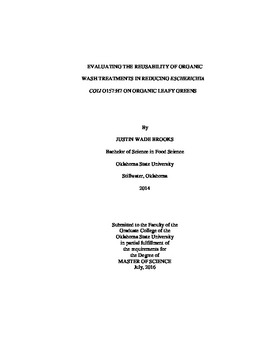| dc.contributor.advisor | Jaroni, Divya | |
| dc.contributor.author | Brooks, Justin Wade | |
| dc.date.accessioned | 2017-02-22T22:13:59Z | |
| dc.date.available | 2017-02-22T22:13:59Z | |
| dc.date.issued | 2016-07-01 | |
| dc.identifier.uri | https://hdl.handle.net/11244/49053 | |
| dc.description.abstract | In recent years, organic leafy-greens have been associated with Escherichia coli O157:H7 related outbreaks. Approved antimicrobials for organic produce are limited, resulting in investigations into plant-derived alternatives. Oregano and cinnamon essential oil (EO) and their primary constituents, carvacrol and cinnamaldehyde, respectively, have proven to be effective against E. coli O157:H7. Flume-tank washing of organic greens, prior to packaging, is common practice where wash water is re-used multiple times before being discarded. It is therefore important to evaluate the re-usability of antimicrobials during flume-tank wash. The purpose of this study was to evaluate the re-usability of essential oils and their primary constituents for flume-tank washing of organic leafy-greens to reduce E. coli O157:H7. Oregano and cinnamon EO and carvacrol and cinnamaldehyde were tested at 0.5% concentration. Additionally a Fulvic Acid III formulation was tested at 3% concentration. Hydrogen peroxide, water and phosphate buffered saline were used as controls. Organic leafy greens, baby and mature spinach and romaine and iceberg lettuce, were inoculated with E. coli O157:H7 (106 CFU/g). Each antimicrobial was re-used five times to wash (for 1 min) five separate batches of inoculated leafy greens that were stored at 4�C and surviving bacteria enumerated on days 0, 1, and 3. Wash water was enumerated for E. coli O157:H7 after each use and pH and turbidity measured. Tested antimicrobials showed significant (P < 0.05) reduction of E. coli O157:H7 over five washes. Carvacrol and oregano EO were the most effective, reducing pathogen populations to undetectable levels on day 0 in all leafy greens except mature spinach where undetectable levels were achieved on day 3 with carvacrol. Cinnamon EO and cinnamaldehyde were able to reduce pathogen populations to undetectable levels in all leafy greens by day 1. Wash water resulting from the antimicrobial washes did not show any growth of E.coli O157:H7.This study provides evidence that plant-derived compounds could serve as effective sanitizers that retain their antimicrobial activity with continued use. | |
| dc.format | application/pdf | |
| dc.language | en_US | |
| dc.rights | Copyright is held by the author who has granted the Oklahoma State University Library the non-exclusive right to share this material in its institutional repository. Contact Digital Library Services at lib-dls@okstate.edu or 405-744-9161 for the permission policy on the use, reproduction or distribution of this material. | |
| dc.title | Evaluating the Reusability of Organic Wash Treatments in Reducing Escherchia Coli O157:H7 on Organic Leafy Greens | |
| dc.contributor.committeeMember | Jadeja, Ravi | |
| dc.contributor.committeeMember | Mcglynn, William | |
| osu.filename | Brooks_okstate_0664M_14759.pdf | |
| osu.accesstype | Open Access | |
| dc.description.department | Food Science | |
| dc.type.genre | Thesis | |
| dc.type.material | text | |
